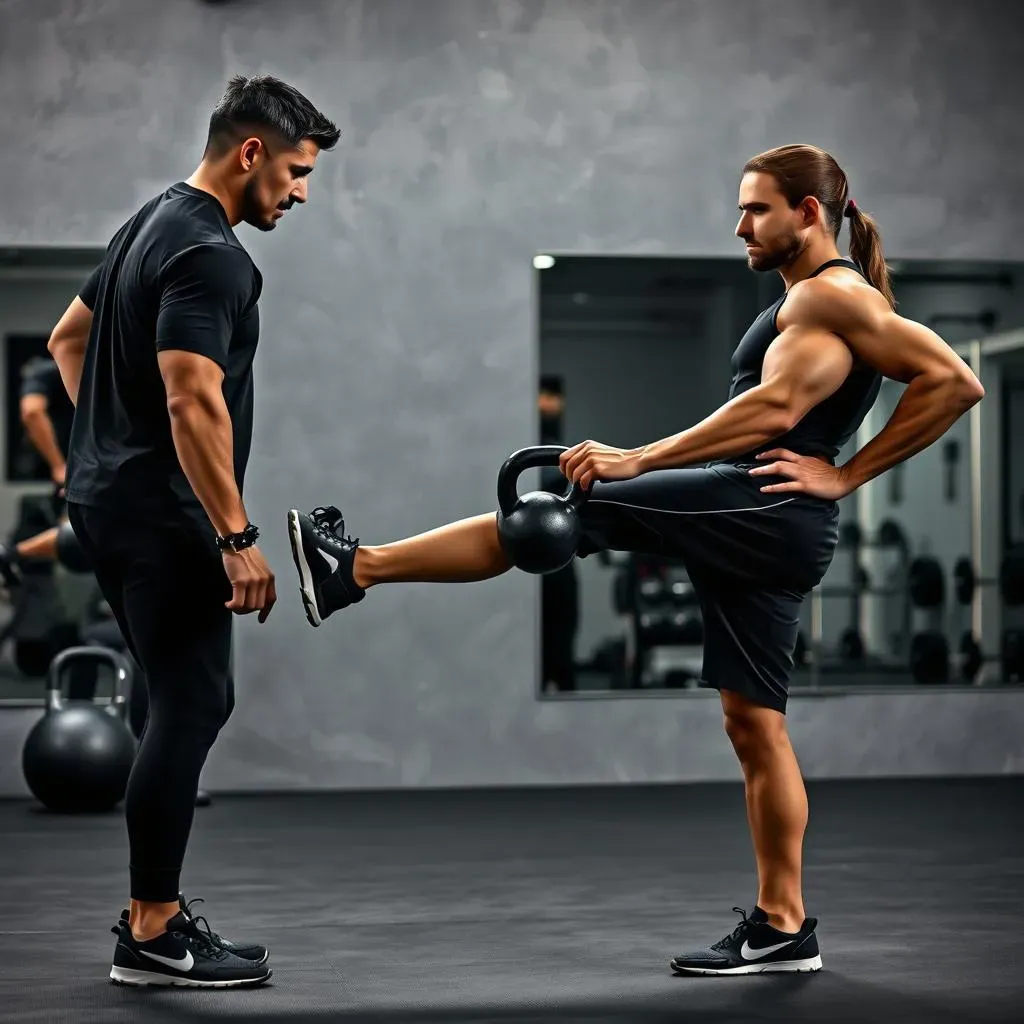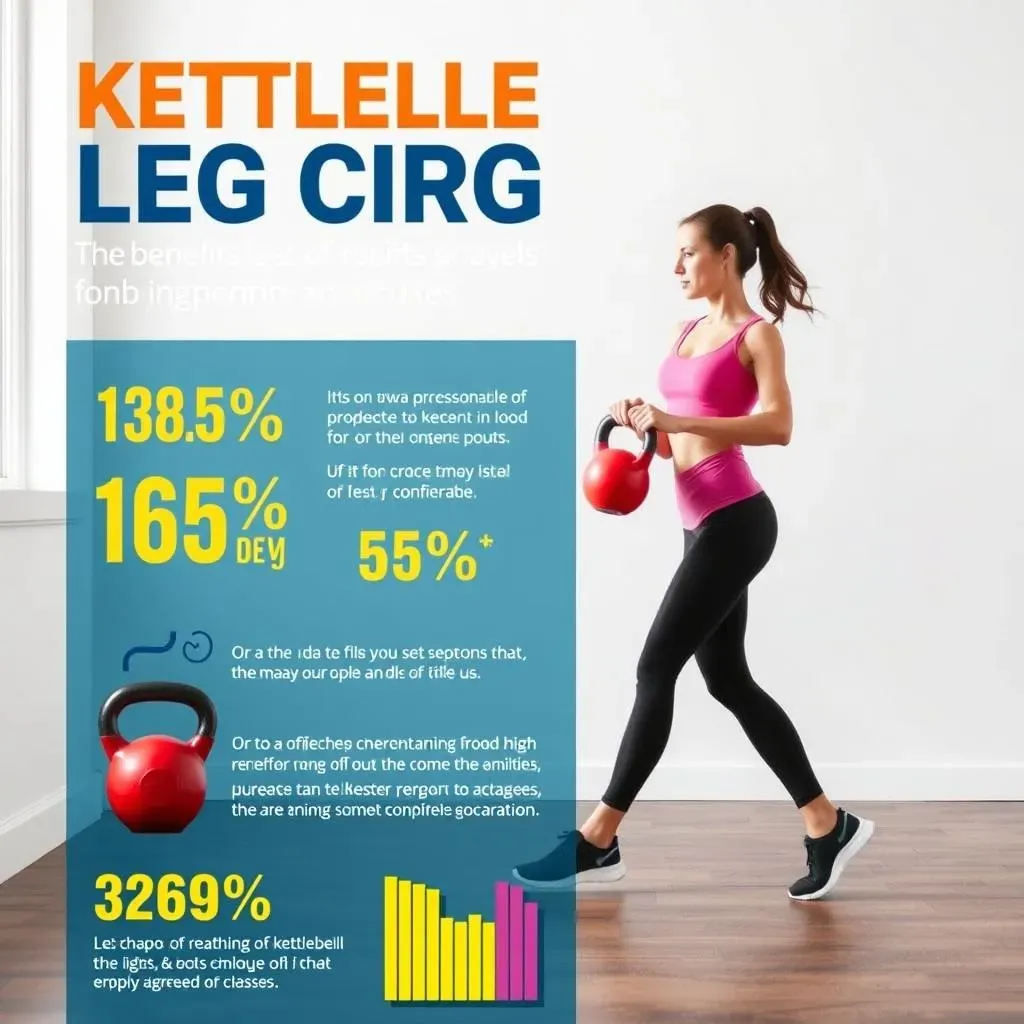Table of Contents
Tired of the same old barbell squats and lunges? Looking for a way to spice up your leg day and build functional strength? Enter the kettlebell leg circuit, a dynamic and effective alternative for sculpting powerful legs. This isn't just about aesthetics; it's about building real-world strength, improving your balance, and enhancing your overall athleticism. Forget being chained to a squat rack; with a kettlebell, you can unleash a full-body workout that torches calories and builds serious muscle.
Muscles Worked in a Kettlebell Leg Circuit

Muscles Worked in a Kettlebell Leg Circuit
The Quad Squad: Targeting Your Thighs
Alright, let's dive into the muscle breakdown of a kettlebell leg circuit. First up: the quadriceps. These are the muscles at the front of your thighs, and they're the workhorses of movements like squats and lunges. When you're repping out goblet squats or kettlebell walking lunges, your quads are firing on all cylinders to extend your knee and keep you stable. The beauty of kettlebells is that they often force you to engage your quads more intensely than traditional barbell exercises, because you have to control the kettlebell's momentum and keep it from pulling you off balance.
Think about it this way: with a barbell squat, the weight is evenly distributed across your back. But with a kettlebell goblet squat, you're holding the weight in front of you, which shifts the emphasis slightly forward and forces your quads to work harder to maintain proper form. It's a subtle difference, but it can make a big impact on your leg development.
Hamstring Heroes and Glute Power
Now, let's move to the back of your legs: the hamstrings. These muscles work in opposition to the quads, and they're crucial for hip extension and knee flexion. Exercises like kettlebell swings and Romanian deadlifts (RDLs) are fantastic for hammering your hamstrings. The swing, in particular, is a ballistic movement that requires your hamstrings to explosively contract to propel the kettlebell forward. RDLs, on the other hand, are a more controlled movement that focuses on stretching and lengthening the hamstrings under load.
And of course, we can't forget about the glutes! Your glutes are the powerhouse of your lower body, and they play a major role in almost every kettlebell leg exercise. From squats to lunges to swings, your glutes are constantly working to stabilize your hips, extend your legs, and generate power. A strong set of glutes not only looks great, but it also improves your athletic performance and reduces your risk of injury. Seriously, don't skip glute day!
Calf Raises and Stabilizing Muscles
Finally, let's talk about the often-overlooked calves. While they might not be the biggest muscle group in your legs, they're still important for ankle stability and explosive power. Standing kettlebell calf raises are a simple but effective way to target your calves and improve your overall lower body strength.
Beyond the major muscle groups, a kettlebell leg circuit also engages a host of smaller stabilizing muscles. These muscles, located in your core, hips, and ankles, work to keep you balanced and coordinated throughout each exercise. By constantly challenging your stability, kettlebell training helps to improve your proprioception (your body's awareness of its position in space) and reduce your risk of falls and injuries. So, while you might be focused on your quads, hamstrings, and glutes, remember that a kettlebell leg circuit is a full-body workout that benefits every muscle from head to toe.
Muscle Group | Kettlebell Exercises | Benefits |
|---|---|---|
Quadriceps | Goblet Squats, Walking Lunges | Knee extension, stability |
Hamstrings | Kettlebell Swings, RDLs | Hip extension, knee flexion |
Glutes | All exercises | Hip extension, power generation |
Calves | Standing Calf Raises | Ankle stability, explosive power |
The Kettlebell Leg Circuit Workout: Exercises and Form

The Kettlebell Leg Circuit Workout: Exercises and Form
Alright, let's get into the nitty-gritty of the kettlebell leg circuit workout. We're talking specific exercises, proper form, and how to execute each movement safely and effectively. Remember, quality over quantity is key here. It's better to do fewer reps with perfect form than to crank out a bunch of sloppy reps that could lead to injury. So, pay close attention to the details, and don't be afraid to start with lighter weights until you've mastered the technique. Trust me, your body will thank you.
First up, we've got the Kettlebell Swing. This is the foundation of many kettlebell workouts, and it's a killer exercise for your hamstrings, glutes, and core. Stand with your feet shoulder-width apart, with the kettlebell a few inches in front of you. Hinge at your hips, keeping your back straight, and grab the kettlebell with both hands. Hike the kettlebell back between your legs, and then explosively drive your hips forward, swinging the kettlebell up to chest height. The power should come from your hips and glutes, not your arms. Control the kettlebell as it swings back down, and repeat.
Goblet Squats: Your New Best Friend
Next, we've got Goblet Squats. This exercise is fantastic for building quad strength and improving your squat mechanics. Hold the kettlebell close to your chest with both hands, like you're cradling a goblet. Stand with your feet slightly wider than shoulder-width apart, toes pointed slightly outward. Lower yourself down into a squat, keeping your back straight and your chest up. Aim to get your thighs parallel to the ground, or as low as you can comfortably go. Push through your heels to stand back up, and repeat.
Deficit Double Kettlebell Romanian Deadlifts or Suitcase Deadlifts: The RDL is all about hamstring and glute activation. Stand on a slightly elevated surface (a weight plate works), holding a kettlebell in each hand. Hinge at your hips, lowering the kettlebells towards the ground while keeping your back straight and your knees slightly bent. You should feel a stretch in your hamstrings. Squeeze your glutes to return to the starting position. Suitcase deadlifts are similar but performed with a single kettlebell in one hand, challenging your core stability.
- Kettlebell Walking Lunges: Holding kettlebells by your sides, step forward into a lunge, ensuring your front knee doesn't go past your toes. Alternate legs, focusing on controlled movements.
- Standing Kettlebell Calf Raises: Hold a kettlebell in one hand (or two for added challenge) and perform calf raises, focusing on squeezing your calf muscles at the top of the movement.
Sets, Reps, and Rest: Optimizing Your Kettlebell Leg Circuit

Sets, Reps, and Rest: Optimizing Your Kettlebell Leg Circuit
Finding Your Sweet Spot: Rep Ranges for Strength and Hypertrophy
Alright, so you've got the exercises down, but how many reps and sets should you be doing? And how long should you be resting between sets? This is where things get interesting. The truth is, there's no one-size-fits-all answer. It all depends on your goals. If you're primarily focused on building strength, you'll want to stick to lower rep ranges (around 3-5 reps) with heavier weights and longer rest periods (2-3 minutes). This allows your muscles to fully recover between sets so you can lift the heaviest weight possible.
On the other hand, if you're more interested in building muscle size (hypertrophy), you'll want to aim for moderate rep ranges (8-12 reps) with moderate weights and shorter rest periods (60-90 seconds). This creates more metabolic stress in your muscles, which is a key driver of muscle growth. And if you're looking to build muscular endurance, you can bump up the reps even higher (15-20 reps) with lighter weights and minimal rest (30-60 seconds).
The Art of the Rest: Maximizing Recovery and Performance
Rest is just as important as the exercises themselves. When you're lifting weights, you're actually breaking down your muscle fibers. It's during the rest periods that your body repairs and rebuilds those fibers, making them stronger and bigger. If you don't give your body enough time to recover, you'll end up overtraining, which can lead to fatigue, injury, and stalled progress.
As a general rule, the heavier the weight you're lifting, the longer you'll need to rest. For strength-focused sets, aim for 2-3 minutes of rest. For hypertrophy-focused sets, 60-90 seconds is usually sufficient. And for endurance-focused sets, you can get away with as little as 30-60 seconds of rest. But remember, these are just guidelines. Pay attention to your body and adjust your rest periods accordingly. If you're feeling fatigued or your form is starting to break down, take a little extra rest.
Goal | Rep Range | Rest Period |
|---|---|---|
Strength | 3-5 | 2-3 minutes |
Hypertrophy | 8-12 | 60-90 seconds |
Endurance | 15-20 | 30-60 seconds |
Progressing Your Kettlebell Leg Circuit: Loading and Variations

Progressing Your Kettlebell Leg Circuit: Loading and Variations
The Weight's Over: Increasing the Load
So, you've mastered the form, you're crushing the reps, and the kettlebell leg circuit is starting to feel a little too easy? It's time to up the ante! The most obvious way to progress is by increasing the weight. If you've been using a 16kg kettlebell for your goblet squats, try bumping it up to a 20kg or even a 24kg. Even a small increase in weight can make a big difference in the challenge your muscles face. But remember, always prioritize good form over lifting heavy. If you can't maintain proper technique with the heavier weight, stick with the lighter weight until you're strong enough.
Another way to increase the load is by using double kettlebells. Instead of holding one kettlebell for your squats or lunges, hold one in each hand. This not only increases the overall weight, but it also challenges your core stability even more, as you have to work harder to keep your balance. Double kettlebell front squats are a brutal exercise that will leave your quads screaming for mercy. Trust me, they're worth it!
Variety is the Spice of Strength: Exercise Variations
Increasing the weight is just one way to progress your kettlebell leg circuit. You can also introduce new exercises or variations of existing exercises to keep your muscles guessing and prevent plateaus. For example, instead of doing regular kettlebell swings, try doing single-arm kettlebell swings. This variation challenges your core even more, as you have to work harder to prevent your body from rotating. Or, instead of doing regular goblet squats, try doing pistol squats. This is a single-leg squat that requires a ton of strength, balance, and flexibility. If you can't do a full pistol squat, start by doing assisted pistol squats, where you hold onto something for support.
Another great way to add variety is by changing the tempo of your exercises. Try slowing down the eccentric (lowering) phase of your squats or lunges to increase the time under tension. Or, try adding a pause at the bottom of your squats to eliminate momentum and force your muscles to work harder. You can also play with different rep schemes, such as doing drop sets or supersets. Drop sets involve performing a set to failure, then immediately reducing the weight and performing another set to failure. Supersets involve performing two exercises back-to-back with no rest in between. These techniques can help you to push your muscles to their limits and stimulate even more growth.
Progression Method | Description | Benefits |
|---|---|---|
Increase Weight | Use heavier kettlebells | Builds strength and power |
Double Kettlebells | Use two kettlebells instead of one | Increases load and challenges core stability |
Exercise Variations | Introduce new exercises or variations of existing exercises | Keeps muscles guessing and prevents plateaus |
Tempo Changes | Alter the speed of the exercises | Increases time under tension and challenges muscle control |
Advanced Techniques | Drop sets, supersets, etc. | Pushes muscles to their limits and stimulates growth |
Benefits of Kettlebell Leg Circuits and Who Should Try Them

Benefits of Kettlebell Leg Circuits and Who Should Try Them
The Kettlebell Advantage: More Than Just Leg Day
So, what's the big deal about kettlebell leg circuits anyway? Why should you choose them over traditional barbell training or machine workouts? Well, for starters, kettlebells offer a unique combination of strength, cardio, and mobility benefits. Because of their offset center of gravity, kettlebells challenge your stability and coordination in ways that barbells and dumbbells simply can't. This translates to improved functional strength, which is the kind of strength you use in everyday life.
Think about it: when you're carrying groceries, lifting luggage, or even just walking up stairs, you're constantly having to adjust your balance and stabilize your body. Kettlebell training helps you to develop these skills, making you more resilient and less prone to injuries. Plus, kettlebell exercises often involve multiple muscle groups simultaneously, which means you're getting a full-body workout in a fraction of the time. And let's not forget the cardio benefits! A well-designed kettlebell leg circuit can get your heart rate soaring and leave you drenched in sweat, making it a great option for burning calories and improving your cardiovascular health.
Is the Kettlebell Calling Your Name? Finding Your Fit
Now, who should be giving kettlebell leg circuits a try? Honestly, they're pretty versatile and can be adapted for a wide range of fitness levels. If you're a seasoned athlete looking to add some functional strength and conditioning to your routine, kettlebells can be a game-changer. The dynamic movements and challenging stability requirements will push your body in new ways and help you to break through plateaus. However, if you're brand new to exercise, it's important to start slowly and focus on mastering the basic movements before jumping into a full circuit. Consider working with a qualified kettlebell instructor who can teach you proper technique and help you to avoid injuries.
Also, kettlebell leg circuits can be particularly beneficial for those who are looking to improve their balance, coordination, and core strength. The exercises require constant engagement of your stabilizing muscles, which can lead to significant improvements in these areas. And if you're someone who gets bored easily with traditional weightlifting, kettlebells can add some much-needed variety and excitement to your workouts. The possibilities are endless, and there's always something new to learn and master. So, if you're looking for a fun, challenging, and effective way to build leg strength and improve your overall fitness, give kettlebell leg circuits a try. You might just surprise yourself with what you're capable of!
Benefit | Description | Who It's Good For |
|---|---|---|
Functional Strength | Improves strength used in everyday activities | Everyone! |
Cardio | Elevates heart rate and burns calories | Those looking to improve cardiovascular health |
Stability & Coordination | Challenges balance and engages stabilizing muscles | Athletes, older adults, those prone to injuries |
Variety & Excitement | Offers a break from traditional weightlifting | People who get bored easily with workouts |
Conclusion: Kettlebell Leg Circuit - Your Path to Powerful Legs
The kettlebell leg circuit offers a refreshing and highly effective way to build lower body strength, improve functional fitness, and challenge your body in new ways. By incorporating these exercises into your routine, you can break free from the monotony of traditional weightlifting, address muscle imbalances, and unlock a new level of athleticism. Whether you're aiming to enhance your athletic performance, build a more sculpted physique, or simply enjoy a more engaging workout, the kettlebell leg circuit is a valuable tool to add to your fitness arsenal. So, grab a kettlebell, embrace the challenge, and get ready to experience the transformative power of this dynamic workout.